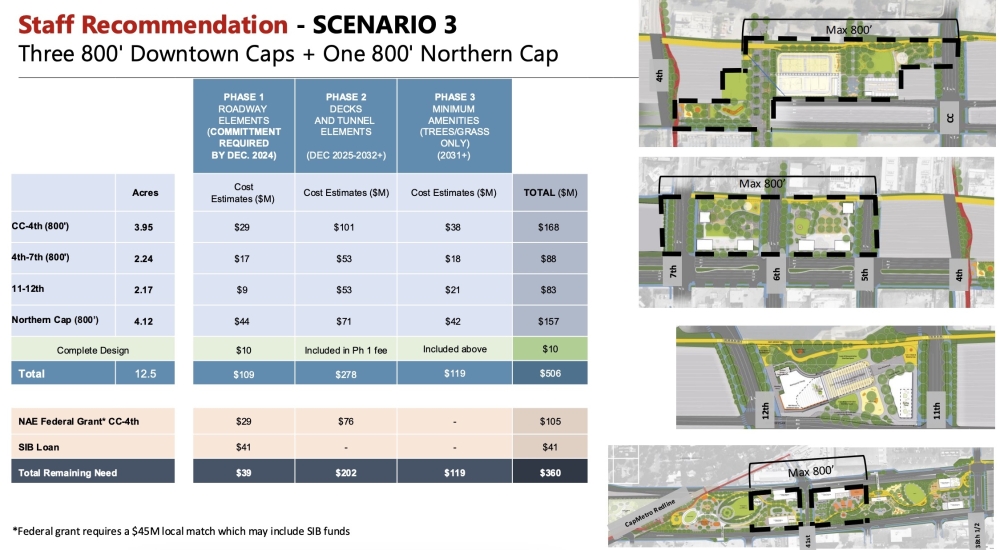The big picture
Over the next decade, the Texas Department of Transportation will be reworking and widening an 8-mile stretch of I-35 through the city.
TxDOT's $4.5 billion Capital Express Central will remove I-35's raised lanes, lower the road, add new lanes, and improve east-west highway crossings for vehicles, pedestrians and cyclists. State officials formally broke ground on the project running between Hwy. 71 to the south and US 290 to the north on Oct. 30.
Community groups and local officials have opposed the state I-35 expansion along the way. But with the project rolling ahead, the city has sought to minimize its impact and better connect the highway's east and west sides through caps and stitches.
That plan, Our Future 35, calls for more than two dozen acres of amenity decks atop the wider, sunken I-35 between Lady Bird Lake and Airport Boulevard. A vision plan for the project based on resident input calls to reconnect communities on both sides of the highway with new parks, public markets, trails, pavilions and art installations on the proposed caps.
What's happening
Construction of Austin's caps and stitches around downtown and the Hancock and Cherrywood neighborhoods was estimated to cost nearly $900 million earlier this year. The plan is not tied to proposed caps around The University of Texas at Austin campus, which are being developed separately and would be funded by the institution.
City officials are now nearing a deadline to decide where future caps and stitches will be placed. TxDOT will build the highway with room for the features the city desires, but Austin must commit to paying for the roadway infrastructure needed for those decks before the end of the year.
Given a total price tag that's now estimated at $1.4 billion and funding uncertainty, city transportation staff are now recommending a significantly scaled-back plan focused on downtown.

The cost
While Austin has scored some funding so far, money for the vast majority of the cap and stitch plan has yet to be found.
One certainty in any version of the plan is the more than 5-acre cap covering East Cesar Chavez to Fourth streets. The city won a $105.2 million federal grant for the project this year, with a $45 million local match. Austin will also be accepting a $41 million state loan for caps next month.
That still leaves hundreds of millions of dollars to secure. A combination of city-issued debt, a future bond election, further state and federal support, and new revenue from property taxes and leases on or near the caps are all on the table.

“We are on our way to having to do a [tax rate election] at some point within the not-too-distant future," Deputy Chief Financial Officer Kim Olivares said.
Austin should also seek philanthropic help with the plan, she said, following the lead of cities such as Dallas, Boston, New York and Tulsa that each secured millions in donations for major park projects.
Put in perspective
Officials now have a few weeks to weigh the reduced cap scenarios and decide on a path forward.
Council member Vanessa Fuentes said she hopes the city will focus on downtown features that aren't scaled down, especially as Our Future 35 was meant to be a "silver lining" for residents impacted by the highway expansion. However, she also noted the significant funding needed to realize the full caps could come at the expense of other community priorities such as new parks.
Council member Paige Ellis shared similar thoughts, saying residents are concerned about the project's environmental and fiscal impacts in relation to other city services.
"It has been stated by staff that we’re going to have to look at what parks or library improvements or additional fire stations might have to be pushed down the road, and I know that that is not what our constituents want from us," she said. "There’s a lot of people that see this as mitigation for a project that should’ve had less impacts to begin with. ... As we talk about what voters do and don’t want, we can’t just expect our voters to support our transportation bonds and then not be delivering projects that are ultimately more sustainable and better for the environment.”
Council member Chito Vela said he favors an ambitious approach and would aim to build out the full plan if possible. He also said strategies such as tax increment financing could bring Austin significant revenue if denser, taller buildings are developed on and near the future decks.
“If we're going to go through the trouble of doing this, my sense would be to go ahead and do full caps, and do it right," he said.
A breakdown of the five reduced Our Future 35 options and potential funding can be viewed below.





